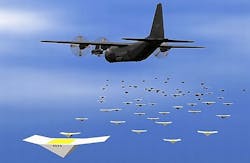Military pursues unmanned swarms of drones working as teams to overwhelm the enemy
Consider the unmanned aerial vehicle (UAV) and most likely you'll think of a single reconnaissance drone tracking terrorists or enemy military forces, or the armed UAV slipping through enemy defenses quickly and quietly for a surgical hit-and-run attack.
All that could be changing, however, because of research programs like the Gremlins program of the U.S. Defense Advanced Research Projects Agency (DARPA) in Arlington, Va.
The DARPA Gremlins program, announced this month, envisions swarms of semi-expendable reconnaissance and electronic warfare (EW) UAVs falling quickly on an unsuspecting enemy to overwhelm opposition by suppressing missile defenses, cutting off communications, spoofing internal security, and perhaps even infecting enemy data networks with computer viruses.
This is all without exposing even one human aircraft pilot to danger. The drones would be launched from C-130 utility turboprop aircraft or similar military planes at safe distances, and unleashed on the enemy.
The swarming drones envisioned in the DARPA Gremlins program would be relatively inexpensive, so their losses wouldn't jeopardized missions or impose crippling costs. Still, Gremlins drones would be sophisticated enough to be recovered, should they survive the mission, and used again several more times. Think of reusable target drones, and you have the idea for Gremlins UAVs.
Simply swarming an enemy with UAVs will be harder than it sounds, however, and several technological challenges remain to be overcome. Perhaps the most important is devising effective and secure ad-hoc wireless networks that would help enable UAVs to communicate and work together in teams.
The contractors ultimately chosen to participate in the DARPA Gremlins program will do just that. These wireless networks must be adaptable and self-healing so that when one drone fails or is shot down, then others automatically assume its responsibilities. As attrition were to factor in to Gremlins-like missions, the remaining drones would continue on with surveillance duties, electronic jamming, communications eavesdropping, cyber warfare, or other assigned tasks.
After completing the mission, surviving drones would rendezvous at a pre-determined location and be recovered by the host C-130 aircraft. Sneak in, swarm and overwhelm the enemy, and then leave. That's the objective.
DARPA isn't alone in pursuing swarming drones technologies; a wide variety of military agencies are trying to develop the ability to swarm the enemy with UAVs. The DARPA Gremlins program simply is one of the latest initiatives, and will help give depth and focus to military drone swarming research.
DARPA wants Gremlins program proposals by November.

